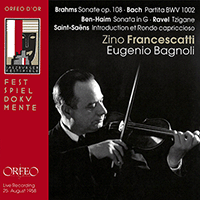Zino Francescatti
René-Charles Francescatti, known as Zino, was born to two violinists. His father, Fortunato, had studied with the man who was reportedly Paganini’s sole pupil: Camillo Sivori, a virtuosic showman of the violin and composer of several violin works including two concertos. Zino’s mother, twenty-nine years younger than Fortunato, was herself a former pupil of her husband and a violinist of distinction.
With such illustrious parentage it is hardly surprising that Zino was encouraged to learn the violin; but although there was a long tradition of violinists of his time and earlier commencing studies with parental guidance, Zino was unusual in being trained throughout exclusively by his parents and thus, in this sense, was independent of the major conservatories which produced the vast majority of players of the recording era. His mother took charge of Zino’s practice routines whilst his father concentrated mainly upon artistic cultivation. By all accounts they were successful, and whilst still in his teens Zino was to make his first recordings. Fortunato was an ardent perfectionist, reluctant to release his son into a performing career too early. Aged only ten, however, Zino performed Beethoven’s Violin Concerto with an orchestra to an audience reception so enthusiastic that his father was forced to admit that this talent was indeed ready for the concert hall.
In his twenties Francescatti went to Paris and earned his living teaching and playing in orchestras. Jacques Thibaud was impressed by his début solo performance at a Conservatoire concert and helped to promote him in his early career. An encounter with Maurice Ravel was similarly fruitful; they became friends and toured Britain together in 1926, showing off Ravel’s recent compositions such as the Berceuse and Tzigane. Francescatti was evidently keen to promote new music, frequently programming repertoire by contemporaries such as Prokofiev, Stravinsky, Milhaud, Walton, Bernstein and Hindemith. He became renowned for his renditions of Paganini’s Violin Concerto No. 1, in which audiences perceived an artistic line of descent from the composer himself. It was this work that won over a New York audience in 1939, and shortly afterwards Francescatti settled in New York.
Although he admitted gratitude for his father’s very rigorous regime of tuition, Francescatti was much more relaxed in his own pedagogic approach. Teaching first at the École Normale de Paris, later in America and then in Provence, his priority was always to nurture and encourage young, talented musicians towards releasing their individuality in musical expression.
Francescatti was universally admired and liked by contemporary violinists and was very widely recorded with orchestras. Tully Potter holds that his best recordings of concertos include the 1959 Brahms Double, under Bruno Walter’s baton with the cellist Pierre Fournier, and Saint-Saëns’s Violin Concerto in B minor with Dimitri Mitropoulos and the New York Philharmonic of 1950, which shows his suave and sophisticated tone to great advantage in French repertoire. The Brahms rendition brings a Gallic charm to the richer, darker sonorities of this erudite and passionate work, notwithstanding Walter’s pedigree and just claim to understand first-hand something of Brahms performance and the late nineteenth-century legacy. The Fournier/Francescatti performance has a certain lightness and brilliancy that sits rather uncomfortably within the textures of the work. Francescatti’s tone belongs to a later age and has notably different priorities from the style of the surviving ‘elder statesmen’ who had a more direct lineage to the Berlin/Joachim classical style of playing.
Indeed, Francescatti greatly admired the modernising ethos of Fritz Kreisler, recording many of his miniatures and using them as encores. Although his sound is in some ways dissimilar to Kreisler’s, like the older player he was known for his ever-present vibrato which, as film footage reveals, was often relatively slow and wide. With Kreisler, there is a solidity to the tone which, even without the vibrato, one can well imagine would have something of the depth and power of violinists trained in Joachim’s circle—in the Joachim school, of course, a fundamentally non-vibrato tone was encouraged. As with many twentieth-century players, Francescatti’s vibrato is not applied as an adornment to the sound but becomes a basic constituent part of it, lending, in his case, a silvery brightness and sophisticated gloss.
An episode that occurred during a pre-recording rehearsal of Brahms’s Violin Concerto raises the question of how much a performer’s sound is attributable to the instrument they play. Francescatti had, around 1942, acquired the 1727 ‘Hart’ Stradivarius which was thought by critics to be largely responsible for creating a stronger, richer tone in his playing; the instrument, however, became unusable during rehearsal and Kreisler, who happened to be present, offered his own Guarnerius del Gesù. Francescatti’s duo partner, Robert Casadesus, arrived at the rehearsal unaware of this and stated that he could have sworn it was Kreisler playing.
Francescatti’s performance of Paganini’s infamous Caprice No. 24 (with piano accompaniment by Artur Balsam in Pilati’s arrangement) displays these features well. The tone is refined, but suffers from a slightly monotonous and metallic quality. On the face of it, the playing is invulnerable but careful listening reveals some questionable double-stop intonation in an admittedly very difficult work. Nonetheless, it exhibits Francescatti’s heritage as a third-generation Paganini pupil and one of very few important violinists of Italian blood at this time.
© Naxos Rights International Ltd. — David Milsom (A–Z of String Players, Naxos 8.558081-84)


















